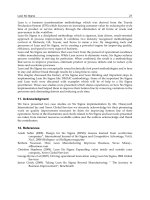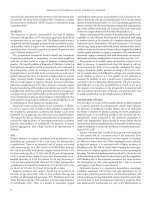Chapter 051. Menstrual Disorders and Pelvic Pain (Part 3) pptx
Bạn đang xem bản rút gọn của tài liệu. Xem và tải ngay bản đầy đủ của tài liệu tại đây (143.17 KB, 5 trang )
Chapter 051. Menstrual Disorders
and Pelvic Pain
(Part 3)
Algorithm for evaluation of amenorrhea. β-hCG, human chorionic
gonadotropin; PRL, prolactin; FSH, follicle-stimulating hormone; TSH, thyroid-
stimulating hormone.
Hypogonadotropic Hypogonadism
Low estrogen levels in combination with normal or low levels of LH and
FSH are seen with anatomic, genetic, or functional abnormalities that interfere
with hypothalamic GnRH secretion or normal pituitary responsiveness to GnRH.
Although relatively uncommon, tumors and infiltrative diseases should be
considered in the differential diagnosis of hypogonadotropic hypogonadism
(Chap. 333). These disorders may present with primary or secondary amenorrhea.
They may occur in association with other features suggestive of hypothalamic or
pituitary dysfunction such as short stature, diabetes insipidus, galactorrhea, or
headache. Hypogonadotropic hypogonadism may also be seen following cranial
irradiation. In the postpartum period, it may be due to pituitary necrosis (Sheehan
syndrome) or lymphocytic hypophysitis. Because reproductive dysfunction is
commonly associated with hyperprolactinemia, either from neuroanatomic lesions
or medications, prolactin should be measured in all patients with
hypogonadotropic hypogonadism (Chap. 333).
Isolated hypogonadotropic hypogonadism (IHH) is more common in men
than women and is often associated with anosmia. IHH generally presents with
primary amenorrhea. A number of genetic causes of IHH have been identified
(Chaps. 340 and 341).
Functional hypothalamic amenorrhea (HA) is caused by a mismatch
between energy expenditure and energy intake. Leptin secretion may play a key
role in transducing the signals from the periphery to the hypothalamus in HA. The
hypothalamic-pituitary-adrenal axis may also play a role. The diagnosis of HA can
generally be made on the basis of a careful history, physical examination, and the
demonstration of low levels of gonadotropins and normal prolactin levels. Eating
disorders and chronic disease must be specifically excluded (Chap. 76). An
atypical history, headache, signs of other hypothalamic dysfunction, or
hyperprolactinemia, even if mild, necessitates cranial imaging with CT or MRI to
exclude a neuroanatomic cause.
Hypergonadotropic Hypogonadism
Ovarian failure is considered premature when it occurs in women younger
than age 40. Ovarian failure is associated with the loss of negative-feedback
restraint on the hypothalamus and pituitary, resulting in increased FSH and LH
levels. FSH is a better marker of ovarian failure as its levels are less variable than
LH. As with natural menopause, premature ovarian failure (POF) may wax and
wane, and serial measurements may be necessary to establish the diagnosis.
Once the diagnosis of POF has been established, further evaluation is
indicated because of other health problems that may be associated with POF. For
example, POF is seen in association with a variety of chromosomal abnormalities
including Turner syndrome, autoimmune polyglandular failure syndromes, radio-
and chemotherapy, and galactosemia. In the majority of cases, however, a cause is
not determined. The recognition that early ovarian failure occurs in premutation
carriers of the fragile X syndrome is important because of increased risk of severe
mental retardation in male children with FMR1 mutations.
Hypergonadotropic hypogonadism occurs rarely in other disorders, such as
mutations in the FSH or LH receptors. Aromatase deficiency and 17α-hydroxylase
deficiency are associated with elevated gonadotropins with hyperandrogenism and
hypertension, respectively. Gonadotropin-secreting tumors in women of
reproductive age generally present with high, rather than low, estrogen levels and
cause ovarian hyperstimulation or dysfunctional bleeding.
Amenorrhea Caused by Ovulatory Disorders: Treatment
Amenorrhea is almost always associated with chronically low levels of
estrogen, whether it is caused by hypogonadotropic hypogonadism or ovarian
failure. Development of secondary sexual characteristics requires gradual titration
of estradiol replacement with eventual addition of a progestin. Symptoms of
hypoestrogenism can be treated with hormone replacement therapy or oral
contraceptive pills. Patients with hypogonadotropic hypogonadism who are
interested in fertility require treatment with pulsatile GnRH or exogenous FSH and
LH, whereas patients with ovarian failure can consider oocyte donation, which has
a high chance of success in this population.
Polycystic Ovarian Syndrome (PCOS)
This is diagnosed based on the presence of clinical or biochemical evidence
of hyperandrogenism in association with amenorrhea or oligomenorrhea.
Symptoms generally begin shortly after menarche and are slowly progressive.
Lean patients with PCOS generally have high LH levels in the presence of normal
to low levels of FSH and estradiol. The LH/FSH abnormality is less pronounced in
obese patients in whom insulin resistance is a more prominent feature. Most
patients also have a polycystic ovarian morphology on ultrasound, although there
is controversy as to whether this morphology in combination with
hyperandrogenism is sufficient for the diagnosis of PCOS.









